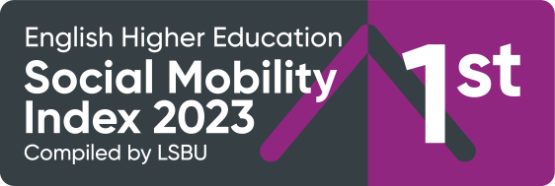University of Bradford tops Social Mobility Index for third year running
The University of Bradford has been ranked first in England on the Social Mobility Index (SMI) for the third year running.

The SMI ranking, produced by the Higher Education Policy Institute, is a way of ranking universities based on the impact they have on people’s social mobility.
The University was ranked top in 2021, 2022 and again in 2023.

Vice-Chancellor Professor Shirley Congdon, pictured above, said: “I am delighted the University of Bradford has been ranked first nationally in the 2023 Social Mobility Index. This is testament to our core ambition to make a difference for our students, the city, and society in general.
“At Bradford, the principle of equality of opportunity is at the heart of who we are, what we do, how and why we do it. We take tremendous pride in placing inclusion front and centre in our mission, vision, and values. We are fiercely committed to widening access to higher education through our approach to recruitment and admissions.”
“Moreover, our graduate outcomes stand out not only because of the ‘designed-in’ approach the University takes to student employability, but because of the expertise and dedication of our Careers and Employability Service in supporting students throughout their journey.
“It is this whole-system approach that underpins our success in delivering social mobility for our students, a systems model to inclusion as a means of accelerating equality for all, making our diversity count, and enabling everyone to achieve their full potential.”
We are fiercely committed to widening access to higher education through our approach to recruitment and admissions.
The SMI combines data relating to access, continuation and graduate outcomes. This year, for the first time, the full ranking table has been published.
The story of care leaver Aimee Brannan, pictured below, epitomises the University's approach to social mobility. She graduated with a degree in criminology in 2023, after "scraping through her GCSEs" and having a difficult childhood - read about Aimee's experience.

Professor David Phoenix, Vice-Chancellor of LSBU, who compiles the Index for HEPI, said: “While numerous studies demonstrate that your personal circumstances and where you grow up have a strong bearing on your likelihood of achieving upward mobility, the 2023 Higher Education Social Mobility Index shows that your background does not have to determine your future.
“Universities of all types, up and down the country, are countering expectations by consistently delivering improved economic prosperity for some of our most disadvantaged students.
“The Government has repeatedly expressed its desire to tackle the regional inequalities holding communities back. One of the simplest ways they could do this is by celebrating the success of these institutions in breaking through international norms and ensuring that, in a climate of ever-dwindling resources, we don’t let a lack of finance inadvertently reinforce the glass ceiling and stifle this incredible pipeline of talent.”
The 2023 Higher Education Social Mobility Index shows that your background does not have to determine your future

Nick Hillman, Director of the Higher Education Policy Institute (HEPI), pictured above in the main image, said: “The Social Mobility Index is now in its third year and it has rapidly become one of the most impactful things HEPI does. League tables are controversial and have pros and cons but they are not going to disappear, so it is illuminating to think about different methodologies and to measure things typically excluded.
“The fact that some relatively new and less prestigious institutions beat Oxbridge reminds us of the different contributions made by different institutions. Above all, the Index confirms our higher education sector has strength in breadth. We hear common complaints that there are too many universities and too many students, but this Index provides yet more evidence that higher education institutions of all types transform people’s lives.”
University of Bradford's approach
- ‘Designed in’ approach: we provide curricular and extra-curricular opportunities for students to engage in meaningful career-focused learning that is subject-specific.
- We work in partnership with more than 3,000 local, national, and international employers to offer real world career development education and support the ethos of achieving ‘more than a degree’.
- Our ‘whole systems approach’ means we connect marketing, recruitment and admissions at the front end of the student journey and follow through with evidenced-led career support that builds pathways into high-skilled employment.
- Our total commitment to inclusion is foundational in the sense that it can be traced as a golden seam that runs through all our strategies, policies, decision-making and values.

More about the SMI
The English Higher Education Social Mobility Index (SMI) ranks English universities registered with the Office for Students (excluding specialist institutions) by their contribution to social mobility, based on the social distance travelled by their graduates.
It combines measures of a) access, b) continuation and c) graduate outcomes for undergraduate students. All modes of study are included, although apprenticeship students are necessarily excluded due to a shortage of comparable data.
The following measures are included and reported separately for each year, mode and Index of Multiple Deprivation (IMD) quintiles 1 and 2:
- Access: Access is measured by the proportion of new entrants from Index of Multiple Deprivation Quintiles 1 and 2 at each provider.
- Continuation: Continuation is measured by the Office for Students’ Continuation indicator, which records the percentage of first-year students who complete their course or remain in UK higher education for 12 months (full-time students) or 24 months (part-time students) after starting their course.
- Note: Because the Office for Students’ Access and Participation dataset splits all data by mode (FT and PT), the data inputs are pulled into the model by mode and then pro-rated by the FT/PT headcount split.
- Graduate Outcomes: Graduate Outcomes are measured by two components which are given equal weight and combined:
- Graduate Outcomes as measured by the percentage of graduates with ‘Positive Outcomes’ in the Office for Students’ Proceed definition. The Proceed Definition counts highly skilled employment, any further study and other activities (except ‘Doing something else’) as positive outcomes; and medium / low skilled employment and unemployment as negative outcomes.
- Median salaries as measured in the Graduate Outcomes survey.
Full SMI index
- University of Bradford
- Aston University
- City, University of London
- King's College London
- London School of Economics and Political Science
- Queen Mary University of London
- Birmingham City University
- The University of Wolverhampton
- The University of Huddersfield
- University College London
- London South Bank University
- The University of Salford
- Imperial College of Science, Technology and Medicine
- The University of Bolton
- The University of Greenwich
- The University of Cambridge
- Newman University
- Brunel University London
- Birkbeck College
- The University of Leicester
- The University of Oxford
- The University of Manchester
- Teesside University
- The University of East London
- Canterbury Christ Church University
- The University of Warwick
- The University of Westminster
- Edge Hill University
- The University of Sunderland
- Kingston University
- The University of Central Lancashire
- Leeds Trinity University
- The University of Birmingham
- Liverpool John Moores University
- The Open University
- The Manchester Metropolitan University
- University of Suffolk
- The University of Leeds
- University of Keele
- Staffordshire University
- The University of West London
- The University of Kent
- Sheffield Hallam University
- Middlesex University
- The University of Hull
- Royal Holloway and Bedford New College
- University of Chester
- The University of Lancaster
- Roehampton University
- Liverpool Hope University
- The University of Southampton
- The University of Essex
- Goldsmiths College
- The University of Liverpool
- University of Hertfordshire
- The University of Bath
- The University of Bristol
- The School of Oriental and African Studies
- University of Derby
- University of Nottingham
- Coventry University
- Buckinghamshire New University
- University of Northumbria at Newcastle
- University of Cumbria
- The University of East Anglia
- The University of Sheffield
- De Montfort University
- Loughborough University
- The University of York
- University of Plymouth
- The University of Surrey
- The University of Portsmouth
- University of Newcastle upon Tyne
- University of Durham
- Leeds Beckett University
- London Metropolitan University
- The University of Lincoln
- The Nottingham Trent University
- University of the Arts, London
- University College Birmingham
- Anglia Ruskin University
- The University of Brighton
- The University of Reading
- University of the West of England, Bristol
- University of St Mark and St John
- The University of Sussex
- Bath Spa University
- The University of Northampton
- Bournemouth University
- York St John University
- University of Worcester
- The University of Exeter
- Bishop Grosseteste University
- Solent University, Southampton
- St Mary's University, Twickenham
- University of Gloucestershire
- Oxford Brookes University
- The University of Chichester
- University of Bedfordshire
- Falmouth University
- The University of Winchester
